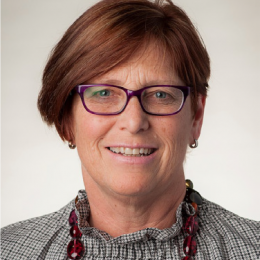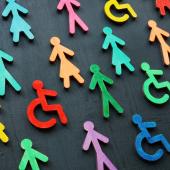Australia’s Aboriginal and Torres Strait Islander population lived on its ancient lands for at least 50,000 years before invasion and immigration began. Today, Indigenous Australians make up a little over three percent of the country’s population and more than 29 percent of Australians were born overseas.
Despite Australia’s multiculturalism, the Australian Human Rights Commission website reports that 39 percent of Australians have experienced racism at work.
So, we wondered, what could our members do to take relevant anti-racist steps at their Australian workplaces? ACC Australia heard Commissioner Chin Tan at the Virtual National Conference in November 2021. He sat down with members Lori Middlehurst and Kelly Xiao for a deep dive on some follow-up questions.
ACC: Thank you Commissioner Tan for spending some additional time with ACC. In your speech, you emphasized the importance of data in ensuring diversity, but many companies in Australia don't currently have any means of collecting this information.
The Diversity Council of Australia talks in terms of "counting culture" rather than races, so, per their work, we should begin by asking employees to self-identify as Aboriginal or Torres Strait Islander first, then ask people for their cultural background. What are your thoughts on that approach?
Commissioner Tan: Firstly, I want to stress the importance of organizations allowing staff to self-identify their cultural background. Secondly, data collection of this kind in the form of surveys or questionnaires needs to be accompanied by a clear rationale in a commitment to diversity, inclusion, and equity.
Fears around discrimination may otherwise justifiably deter those who experience racism from providing this information. Thirdly, we need to collect data that reflects the complex nature of many Australians’ cultural heritage, including second and third generation migrants and taking into account the multiplicity that this background might encapsulate.
We need to collect data that reflects the complex nature of
many Australians’ cultural heritage, including second and third generation migrants and taking into account the
multiplicity that this
background might encapsulate.
I also want to highlight the importance of reflecting the intersectionality of diversity, including, but not limited to, religion, gender, sexuality, and people with disabilities, to speak to the breadth and depth of our society. It is vital that companies are encouraged to collect this data.
Government has a role to play in setting the standard by collecting this kind of data in the public sector in order to benchmark, focus efforts, and measure progress towards racial equity in the workplace.
A new approach
ACC: If you think a different approach is warranted, what are you advocating?
Commissioner Tan: A major focus of the National Anti-Racism Framework is the need for national-level data on the nature and prevalence of racism, and data on key equality measures, including in employment, education, health, and service access. There is an absence of comprehensive or consistent data collection in these categories. We need to tackle the deficiency so we can provide the groundwork for greater discussion and exploration of initiatives, and develop structures to address racism and racial inequality.
Part of the scoping process of the framework development is to gather information on the kinds of data that are being collected so that we can create a platform of good and emerging practice and advocate for a best practice approach.
Customize policies using cultural diversity data
ACC: Multinationals with operations in Australia are sometimes handed the diversity playbook that is used in the organization’s headquarters. So a US company might focus on recruiting from Historically Black Colleges, or recruit from more racially diverse cities than where they are headquartered. Obviously, those actions aren't relevant in Australia. What might we do instead?
Commissioner Tan: Your example highlights the importance of organizations at a workplace level and sector level collecting data and comparing it with available data about the broad makeup of the population. Once the parameters of the diversity challenge are identified, available local information, tools, and resources can be developed and implemented.
The Commission is updating its Workplace Cultural Diversity Tool — an online, confidential self-assessment tool for organizations to determine how they are tracking in line with best practices for cultural diversity and anti-racism. The tool also provides a number of good practice examples of cultural diversity, inclusion, and anti-racism from across a diverse range of Australian workplaces, and provides users with a tailored suite of recommended resources to support further development in these areas.
Use ideas offered by those most affected
ACC: Along those same lines — what can or should Australians take from US campaigns such as Black Lives Matter or Stop Asian Hate?
Commissioner Tan: The Black Lives Matter and Stop Asian Hate movements highlight racism as an urgent issue in Australia. We must address racism at an interpersonal and systemic level. These campaigns demonstrate that those most affected by racism can provide concrete suggestions about anti-racism actions and initiatives.
However, addressing racism is the responsibility of all Australians; in-house counsel have a role to play in influencing law firms or other legal service providers to champion and promote such as education campaigns in their workplaces.
Addressing racism is
the responsibility of all Australians;
in-house counsel have a role to play in influencing law firms or other legal service providers to champion and promote such as education campaigns in their workplaces.
ACC: How should they or could they do this? What might be a concrete first step?
Commissioner Tan: If relevant, in-house counsel could, for example, review supply chain and procurement processes and investigate: Are they equitable? Are there barriers to accessing them? Can they be reformed? Can these processes be used to promote First Nations and culturally diverse suppliers and service providers?
In-house counsel could also look at internal processes around attraction, recruitment, and retention processes. A focus on equity in these areas can help organizations employ the best person for a job, based on a range of factors, and access the diversity of experience, knowledge, and skills enabled only by a workforce that is culturally diverse.
Organizations must think carefully about potential barriers to equitable employment that often occur throughout the attraction and recruitment processes, and ensure that staff development and leadership programs are inclusive. Could workplace professional development requirements be used to build racial literacy and cultural competence? Is a culturally inclusive workplace a strategic priority? And can in-house counsel play a role in promoting this with the organization’s leaders?
ACC: The Australian Workplace Gender Equality Agency (WGEA) is almost 10 years old and under review. WGEA has brought more parity to pay based on gender, by requiring companies with more than 100 employees to report on their overall gender equity and the steps that they are taking to reduce inequity. Should its next iteration include race or intersectionality? How would you envision that might work?
Commissioner Tan: Racial equity monitoring and measurement is a complex undertaking. Other models in overseas jurisdictions, such as the United Kingdom, provide guidance about different ways it could work well. More attention is needed to define the parameters and undertake research options appropriate to the Australian context. This is one of the priorities identified by the National Anti-Racism Framework.
ACC: Your commission’s survey in July 2021 showed that 80 percent of Australian Muslims have experienced discrimination. Emphasizing those results, you have advocated for anti-racism campaigns and workplace programs. What kind of workplace education campaigns do you think are effective?
Commissioner Tan: The National Survey the Commission conducted for the Sharing the Stories of Australian Muslims project reported that almost 80 percent of participants had experienced some form of unfavorable treatment based on their religion, race, or ethnicity. Most of the discrimination occurred in the workplace.
When we spoke to Australian Muslims around the country, we learned that while many workplaces have implemented diversity programs, they are often only partially executed or fail to meet their potential to create change. These findings are echoed in much of what the Commission is currently hearing through its scoping consultations to build a National Anti-Racism Framework — that creating change in workplaces is key to addressing racism across Australian society.
Our National Anti-Racism Framework highlights the many ways in which racial discrimination against Aboriginal and Torres Strait Islander communities perpetuates the ongoing trauma of colonialism.
The Workplace Gender Equality Agency, the Diversity Council of Australia, and the Jumbunna Institute for Indigenous Education provides insight into the racism Aboriginal and Torres Strait Islanders experience in Australian workplaces and describes their particular barriers to seeking and obtaining support.
In particular, the research highlights the intersectional discrimination faced by Aboriginal and Torres Strait Islander women, including that slightly more than 36 percent of the 623 women surveyed strongly disagreed or disagreed that they were able to obtain workplace support when they were treated unfairly or heard racial slurs at work. Women surveyed in the study were more likely to be precariously employed and were underrepresented in management and executive-level positions.
Effective workplace education campaigns acknowledge the complexity and systemic nature of racism and the way it intersects with other forms of discrimination. An effective campaign provides employees with information, tools, and resources to build racial literacy and competence that are culturally safe in practice. It is important that campaigns meet each employee where they are on their learning journey about racism and cultural diversity in the workplace.
Effective campaigns are not one-off training packages or tick-a-box exercises, they must be a part of a larger organizational commitment to long-term learning, reflection, and review of policies, protocols,
and structures.
Assuring the experiences and safety of those affected by intersecting inequalities at work in the design, implementation, and evaluation stages of the campaign is essential toward ensuring that the campaigns succeed. Above all, effective campaigns are not one-off training packages or tick-a-box exercises, they must be a part of a larger organizational commitment to long-term learning, reflection, and review of policies, protocols, and structures.
ACC: What actions can in-house counsel take as part of this workplace education campaign?
Commissioner Tan: In-house counsel are tasked with a critical role — in addition to addressing workplace inequalities and discrimination, GCs must define and frame the architecture and reference points for an organizational culture that fosters and nurtures workplace equality, inclusion, and diversity. In-house counsel hold central roles in the management, legal, and integrity structures in their organizations, and can utilize unique opportunities to promote and champion internal equity outcomes, while instilling best practice anti-racism initiatives.
As with any workplace change, it is important that in-house counsel commit the time and effort necessary toward maintaining culturally relevant anti-racism education campaigns while dealing with competing priorities. Clearly articulating the business case for enhancing diversity to leadership is an important part of maintaining this priority. Finding ongoing opportunities for workplace initiatives that allow staff to build on their learning, for example, through reading groups, employee networks, and volunteer opportunities can be a key path toward building a more inclusive and anti-racist workplace over time.
GCs must define and frame the architecture and reference points for an organizational culture that fosters and nurtures workplace equality, inclusion, and diversity.
ACC: We often hear about racial barriers in career progression faced by legal professionals with multicultural backgrounds. Ninety-five percent of Australian business leaders are white. When you spoke to ABC Everyday, you said,“… There can be assumptions at play about which employees are the right ‘fit’ for leadership.” There is also clear research showing that ethnically diverse executive teams are more profitable. Workers from multi-cultural backgrounds are often told what they can do to break through assumptions, but this places the burden on the individual.
Are there actions legal departments can take to support and promote racially diverse employees to allow them to grow, be noticed and be promoted?
Commissioner Tan: Hire them! Ensure that you develop and implement recruitment processes that demonstrate a stated commitment to diversity. These processes should be embedded within organizational principles and policies that provide guidance on how to create a more equal and diverse workplace.
Ensure, also, that all workplace staff possess racial literacy and learn culturally-safe practices. Work with these employees by providing training and coaching, as may be needed, to address unconscious bias, prejudice, and discrimination.
Racially diverse employees should not be expected to carry the burden of explaining about their culture or heritage to their team members. When there are implicit reasons for them to educate other staff about cultural competency or anti-racism, recognize them for their contributions and/or adjust their workloads to ease the burden.
Organizations must communicate the importance of understanding diverse cultures and that it is valuable for the company’s core business. Building team capacity on diversity requires a specific allocation of resources and staff time.
Organizations need to be upfront about where discrimination occurs and understand that levels of reporting are not necessarily representative of employees’ experiences of discrimination. Legal departments need to ensure transparent mechanisms are in place to address any concerns about inappropriate workplace behavior and that these mechanisms are accessible to those who need them. Legal frameworks and practices in workplaces that address racial discrimination and racism should clearly set goals, standards, and expectations for the organization and staff.
Organizations need to be upfront about where discrimination occurs and understand that levels of reporting are not necessarily representative of employees’
experiences of discrimination.
Legal departments can also help provide flexible and tailored supports to diverse employees throughout their employment journey in the organization. Let the feedback of diverse employees be the guide when it comes to putting in place supportive mechanisms and toward understanding the different kinds of supports that are necessary for employees at different stages of their career.
Lastly, there needs to be strong accountability and evaluation to ensure that the supports put in place are benefiting racially diverse employees. Regular and robust monitoring and reporting is crucial for benchmarking, measuring success, and identifying areas for further improvement.
ACC: What sorts of things can in-house legal departments do to be better allies?
Commissioner Tan: Legal departments can engage actively by learning more about how to improve their cultural diversity and address systemic barriers to participation, including on the basis of race or culture. Being a good ally means being ready to have difficult conversations about whether your own organization is representative of the greater diversity of Australian society and what it can do to be more inclusive.
Being a good ally means being ready to have difficult conversations about whether your own organization is representative of the greater diversity of Australian society and what it can do to be more inclusive.
Legal departments can look to legal colleagues outside their organization’s for examples of best practice around such an approach. We know that in-house counsel and the legal profession are actively involved in anti-racism initiatives and in building the sector’s cultural competence and capacity to create culturally-safe spaces for employees and clients.
The Commission partners with many stakeholders on some of these initiatives. For example, in New South Wales (NSW), the Commission is a member of the Diversity Subcommittee of the Special Joint Data, Policy Subcommittee of the Asian Australian Lawyers Association NSW Branch, and Women’s Lawyers’ Association of NSW. We also support the important work of Diverse Women in Law to empower and support them through all stages of their legal studies and career.
The Commission’s campaign, Racism. It Stops with Me, which is currently undergoing a refresh, defines a good ally as someone who actively recognizes and addresses racial inequality around them by calling out racism where it exists and, above all, listens to people who experience racism, and elevates their voices. Subscribe to stay up to date with ongoing initiatives and opportunities to advocate for racial equality. The campaign will be releasing next year a new Workplace Diversity Tool with resources, self-audit tools, and best practice examples.
ACC: Are you a proponent of mentoring or coaching programs?
Commissioner Tan: Mentoring and coaching programs are an important initiative in workplaces and can play a role in improving an employee’s continued engagement and progress within a workplace. While, in some contexts, having mentors and coaches who have experienced racism can be helpful for diverse employees, even when they do not have this lived experience, mentors and coaches provide important advice to enable employees to thrive and progress in workplaces. Mentors also learn a great deal from those they engage with in these settings.
However, mentoring is just a piece of a greater organizational investment in supporting diverse employees. As the Diversity Council and the Jumbunna Institute’s Gari Yala report highlights, initiating a formal career development program for Aboriginal and Torres Strait Islander employees, as well as Indigenous (Leader/Elder) support or sponsorship of new and young staff, can be high-impact investments that support staff retention and progress. As with all initiatives, mentoring and coaching initiatives should be subject to regular evaluation and review that highlights the feedback of racially diverse employees to ensure they are effective and empowering.
ACC: Any additional thoughts?
Commissioner Tan: We are at a crucial time for addressing racism and racial discrimination in Australia. It is a time for active allyship and open engagement to tackle racism. I invite in-house counsel to join the Commission to see how they can support and endorse the call for a framework more broadly and be a part of the journey of building a National Anti-Racism Framework. The framework will be a long-term, central reference point to guide actions on anti-racism and equality by government, NGOs, business, communities, and other sectors.
It is a time for active allyship and
open engagement to tackle racism.
The Australian Human Rights Commission (AHRC) has created a Framework Conversation and Consultation Guide that organizations can use to guide conversations about the Anti-Racism Framework and submit feedback prior to 29 April 2022.
The AHRC will assist organizations in the facilitation of those discussions.
Putting it into practice: Building a workplace that reflects society
Salesforce’s Legal and Corporate Affairs function, where ACC Australia member Lori Middlehurst serves as senior director for global employment law, has established a Diversity Equality and Inclusion model with a vision to lead the industry in having a diverse, representative, accessible and inclusive team.
Salesforce models representation, diversity, and inclusion at every level of its organization. The company celebrates and elevates diverse voices and leaders to drive more inclusive and better-informed decision making. Salesforce is visible, vocal, and accountable in driving equality, inclusion and belonging in its teams, the company, and its communities through people, purchasing, philanthropy, and policy work.
This vision has led Salesforce to the creation of a cross-functional team, a diversity leader, check-ins with its function where team members share a diversity score card, participation in job fairs and conferences focused on under-represented members of these professions, inclusive hiring and bias training, and development of tools to track participation of underrepresented lawyers on matters and equality progressing pro bono and policy work.





